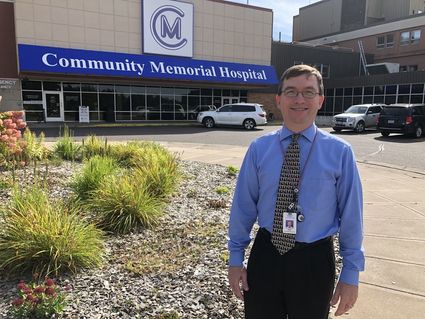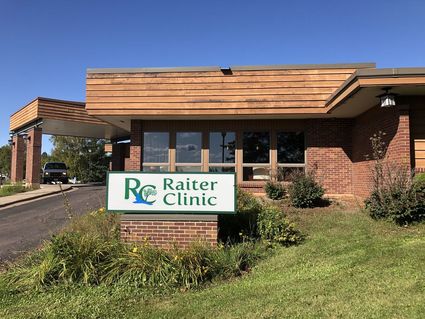Cloquet's health care twins make merger official
Hospital, clinic will focus on local options
September 27, 2019

Jana Peterson
Community Memorial Hospital CEO Rick Breuer doesn't expect any jobs to be lost through the merger with Raiter Clinic and thinks jobs may increase because CMH will likely bring back some services that Raiter has been outsourcing.
Community Memorial Hospital and Raiter Clinic are joining forces, with the goal of keeping independent local health care thriving in the Cloquet area.
The merger came as a surprise for many, some who assumed that the two entities were already operating together.
The two have a long history of collaboration, said Raiter Clinic administrator Craig Ward.
"This partnership is a natural fit for the community," Ward said.
Dr. Jim Rogers, a Raiter Clinic physician, sees it as a positive move for everyone.
"We are excited to see our Raiter Clinic merge with Community Memorial Hospital," Rogers said. "It has been a long time coming and we see it is a win-win-win for the Raiter Clinic, CMH, and for the communities we serve. We will now have a unified medical campus that has retained its local independence."
Working together is what it's all about, said CMH CEO Rick Breuer, explaining that although the nonprofit hospital is actually buying the clinic, the point is to be united, "to partner in local health care."
"There are other health care entities in the region or beyond, that really see opportunities to acquire a practice or a hospital as simply an opportunity to control that facet and draw people to their mothership," he said, pointing a finger at the move by Essentia Health to open a clinic in Cloquet in May 2020. "And we're really about better serving Cloquet and the surrounding communities."
By partnering with Raiter, he said, the two longtime local health care providers will no longer compete with each other - as they have done since CMH opened its own family clinic in May of 2018 - plus they will be able to offer more services. It will also mean local residents won't have to choose between their hometown hospital and their hometown clinic.
The two organizations will become one on Jan. 1, 2020. That gives them time to work out details such as how to make computer systems work together, and maximize efficiencies, Breuer said.
The longtime hospital CEO said he doesn't expect any jobs to be lost - in fact, he thinks jobs may increase, because CMH will likely bring back some services that Raiter has been outsourcing.
Both men said they expect the Raiter Clinic name to survive.
"I have every wish and desire to honor and recognize the Raiter legacy," Breuer said, adding that they need to work out the details. "We'll be sitting down with people from both sides of the street and some of our marketing team to figure out how we want to distinguish the future from the past while still honoring and recognizing the past."
Ward said he doesn't expect a lot of dramatic changes at the clinic.
"Our physicians and staff will be the same," Ward said. "The change that may be noticed is that we will have more providers in the clinic."
Breuer confirmed that the hospital will send its family practice physicians over to Raiter. The surgical and other outreach physicians will stay in the hospital's clinic.
"Raiter will be pretty much a pure family practice clinic," he said. "They've been doing that forever; they are excellent at offering primary care family practice medicine. That's what we're going to leverage. They'll have adequate space for all the providers there and our clinic on this side of the street is going to gain some room by focusing more on the surgical specialties and other outreach docs. It makes more sense for these docs over here to be closer to surgical suites and some of the ancillary services they are more likely to refer to and need."
Rogers is happy too. He acknowledged that the hospital is buying the clinic but stressed that it's a merger, "not a takeover."
"We've had a local culture forever and that remains," he said. "They are acquiring us but this is a two-way street."
Age of expansion
In 2004, in Phase 1 of a building plan for the new millennium, the hospital added a new emergency department that tripled the size of the original one. New surgery suites and day surgery areas were added, as well as a separate imaging department and a remodeled laboratory, among other things.
In 2013, the Phase 2 construction project was completed.
While the $15 million Phase 1 in 2004 dealt with mostly outpatient needs, the $28 million Phase 2 focused on inpatient needs and included an additional 80,000 square feet, so much of the hospital was new. New spaces included three birthing suites with birthing tubs and large comfy areas for family and babies, private rooms, intensive care, infusion therapy rooms, in-house MRI, a chapel, meeting and waiting rooms and more.
Since then, CMH has partnered with other businesses to bring more services to Cloquet, including dialysis, advanced wound care, nephrology and mental health care.
"We've got relationships, yes, with other organizations - we don't need to own and control everything," Breuer said. "We want access to the services, we have physicians and other providers who come in here and simply lease space from us or otherwise use our services. We welcome that."
He pointed out mental health professional Tim Weber who is seeing people there, and Sandy Popham, a nephrologist who comes to CMH to see patients.
They also try to work with other agencies and people in the community, including the schools and public health. And they are part of other organizations, such as Wilderness Health - a coalition of pretty much every non-Essentia hospital in Northeast Minnesota, he said - that works on quality initiatives and other ways of sharing resources like a larger corporation might. They contract with Sisu, which handles IT systems for rural hospitals, and a diagnostic company for imaging and radiology equipment cost sharing.
All of those are examples of ways where we we simply join together with like-minded facilities," he said. "We still want to be who we are. But there's a lot of ways that we can enhance service, or gain efficiencies, save money and share resources, basically."
Of course, they will still refer patients to larger hospitals when they need services that aren't available locally, he said.
But doctors at CMH and Raiter aren't limited to referring patients to one particular facility.
"We'll send patients where it makes the most sense for them," he said. "And hopefully, people do see the value in that versus closed systems where once you're there, you're there. First and foremost, it's always about patient choice. But we also count on the local physician here helping to educate the patient on what all those choices are."
Threat brings unity
In August, news broke in the Pine Knot News that Essentia Health Care is planning to open a Cloquet clinic at the site of the Driftwood Motel, opposite Walmart on the frontage road west of Highway 33. Essentia Health is a network of hospitals, clinics, and related health care facilities serving patients in Minnesota, North Dakota, Wisconsin, and Idaho, based out of Duluth.
Essentia is currently embarking on a massive $800 million Vision Northland building project in Duluth, which will include a new hospital tower, clinic and outpatient surgery center.
"We are expanding our services in Cloquet to meet the health care needs of Essentia Health patients and employees in the area," Essentia Health spokesperson Louie St. George told the Pine Knot in August, regarding the proposed Essentia clinic in Cloquet. According to plans submitted to the city of Cloquet, the planned clinic will be 10,000 square feet - about half the size of the current Raiter Clinic - and include exam rooms, urgent care space, general radiology, a waiting room and other spaces needed in a clinic.
Breuer said he doesn't see the move by Essentia as meeting any kind of unmet need.
"I am a big believer that as a charitable nonprofit healthcare organization, we are supposed to be in the business of meeting unmet needs, serving our charitable purpose," he said, noting that every hospital in Minnesota is set up as a charitable nonprofit entity. "It irks me that I see so many in health care today acting almost like a for-profit corporation: simply trying to drive more market share. They are not meeting an unmet need. They are building a big new building in Duluth, and they're trying to pull more patients to Duluth because they've got to pay for that building."
Essentia Health is not unique in the state. The Mayo Clinic Health System in southern Minnesota has bought up many smaller hospitals and clinics, and eventually reduced services in some of those places, forcing patients to drive to other facilities. In Albert Lea, for example, the hospital no longer offers birthing services.
There are several current options for Cloquet area residents seeking health care. In addition to the primary care services provided by CMH and Raiter, people can also use MedExpress Urgent Care, a neighborhood medical center in the Pine Tree Plaza shopping center. The Fond du Lac Band of Lake Superior Chippewa offers a range of health care services at its Min No Aya Win facility on the reservation.
Rogers is optimistic about the merger with Raiter and the future of the combined organization.
"I've always said health care and education are the cornerstones for the quality of life in a community," he said. "We've got great school systems all around us. And I think we have some great health care facilities and access to great care here, not just at the hospital and the clinic. There are other therapeutic services: chiropractors offices, physical therapy, independent mental health providers, dentists and more. A lot of us make up the health care."
*** A history of health care ***
Before the Raiter Clinic was up in Sunnyside, the Raiter Hospital was in the heart of downtown Cloquet, a three-story building on the northeast corner of Cloquet Avenue and Ninth Street.
Linda Erickson found some interesting remnants of the building's time as a hospital in the basement of the hardware store that she and her husband owned afterward, including a still corked bottle of "Beef, Wine and Iron tonic" for "wasting diseases, dyspepsia alcoholism, nervous debility" and more.
According to the Cloquet "Stories of a Century" Centennial book, the Raiter Hospital was the largest of a handful of Cloquet hospitals and was open from 1926 until 1959. It was opened by doctor brothers Franklin and Roy Raiter. Roy studied surgery in Vienna, so Franklin left the bulk of that work to him. The middle Raiter brother, Roscoe, was a druggist and operated the Raiter Pharmacy on the first floor for many years.
The new Raiter Clinic opened at its current location in February 1960, Rogers said. Rogers said they expanded the clinic building about 10 years ago, and there have been other remodels over the years.

Jana Peterson
Raiter Clinic and Community Memorial Hospital will merge, cementing a longtime cooperative partnership. It will face competition from an incoming Essentia Health clinic.
The $1.7 million Cloquet Community Hospital opened on July 27, 1958, as a 76-bed regional hospital on land donated by the Northwest Paper Company. In addition to funds received through the Hill-Burton Act - which provided 45-percent funding for hospitals in underserved areas - local businesses and residents raised the remaining money to build the new thoroughly modern hospital, which included operating and emergency rooms, lab, X-ray, delivery room and an "all electric kitchen."
In a video on the hospital's website, Dr. Lloyd Backus talked about starting at the hospital in 1958. He and his brother were drawn to Cloquet by the new hospital facility.
"We all knew each other; we felt like a family," he said. "I suspect that's still true here in this hospital, even though it looks like it's about five times as big as it was when I was here."
Seven years later, in 1965, a 44-bed nursing home was built adjoining the hospital; not long after, another floor and 46 more beds were built in the nursing home now known as Sunnyside Health Care Center.








